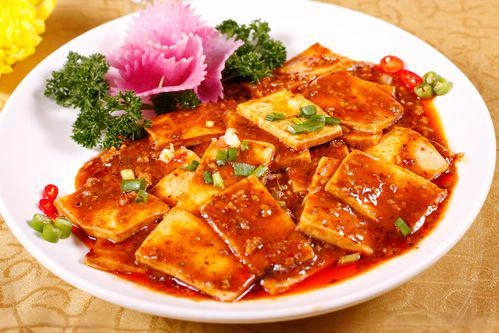West Ba of Leshan: A Culinary Journey Through the Art of Tofu
Introduction:
As a culinary professional, I am thrilled to share the story of West Ba tofu from Leshan City in Sichuan Province, a gastronomic treasure that has captivated food enthusiasts for centuries. Renowned for its exquisite craftsmanship and diverse culinary applications, West Ba tofu is not just a dish; it is a testament to the rich cultural heritage of Sichuan and a culinary art form that has been passed down through generations.
Origins and Cultural Background:
The origins of West Ba tofu can be traced back to the Song Dynasty, where it was first crafted using a traditional method that has been honed and perfected over the centuries. This tofu is deeply rooted in the culinary culture of Sichuan, a province known for its bold flavors and innovative food preparations. As the birthplace of Mapo Tofu, West Ba has earned its place in culinary history as a guardian of one of China’s most iconic dishes.
Ingredients and Preparation:
The making of West Ba tofu is a labor of love that begins with the selection of the finest soybeans. These beans are soaked, ground, and then combined with pure, mineral-rich water from the local area. The slurry is then heated and coagulated, resulting in a delicate, silky tofu with a unique texture that sets it apart from other varieties. The process is a meticulous one, requiring skill and patience to achieve the perfect balance of smoothness and firmness.
Taste and Texture:
West Ba tofu boasts a delicate, melt-in-your-mouth texture that is both soft and firm, allowing it to absorb the flavors of the accompanying dishes without losing its distinct identity. Its taste is subtle and neutral, providing a canvas for a myriad of flavors to shine through. The silkiness of the tofu, combined with its ability to hold sauces and spices, makes it an ideal ingredient for a wide range of dishes.
Visual Description:
Visually, West Ba tofu is a sight to behold. Its pristine white color is a symbol of purity and freshness, and its smooth, even surface is a testament to the precision of its crafting. When cooked, the tofu takes on a slightly golden hue, adding to its appeal and indicating its readiness to be savored.
Representative Dishes and Cuisines:
West Ba tofu is the star of the famous 300-dish tofu banquet, a culinary spectacle that showcases the versatility of this ingredient. From the iconic Mapo Tofu, a spicy and aromatic dish with a rich, velvety sauce, to more subtle preparations like Tofu in Broth, the possibilities are endless. Each dish highlights a different aspect of West Ba tofu, whether it’s its ability to absorb flavors, its textural properties, or its visual appeal.
Culinary Characteristics:
The culinary characteristics of West Ba tofu are as diverse as its applications. Its delicate nature allows it to be a的主角 in both vegetarian and non-vegetarian dishes, while its neutral flavor makes it a versatile ingredient that can be adapted to suit a variety of palates. The tofu’s ability to absorb and retain heat and flavors without breaking down is a testament to the非遗技艺 (intangible cultural heritage) that has been passed down through generations of tofu makers in West Ba.
Conclusion:
West Ba tofu is more than just a food; it is a culinary legacy that continues to evolve and inspire. As a food professional, I am in awe of the craftsmanship and the depth of flavor that this humble ingredient can bring to a dish. It is a testament to the enduring spirit of Sichuan cuisine and a reminder of the rich cultural tapestry that shapes our culinary world. Whether enjoyed in its simplest form or as part of a complex, multi-course meal, West Ba tofu remains a shining star in the constellation of Chinese gastronomy.
